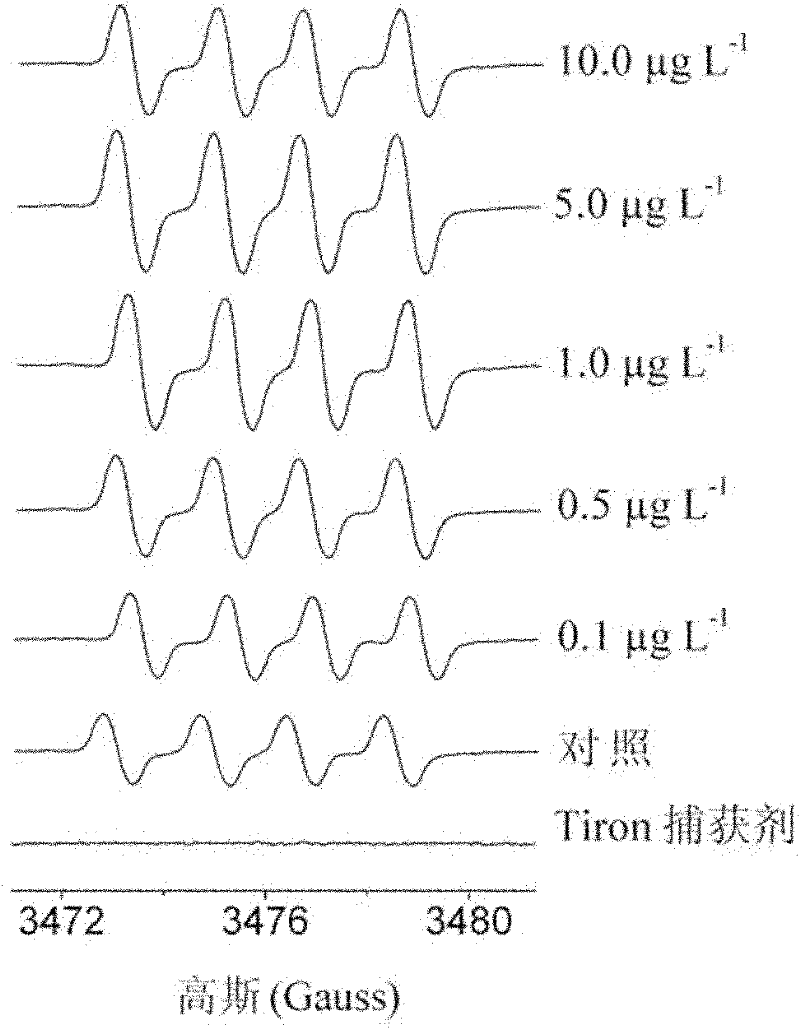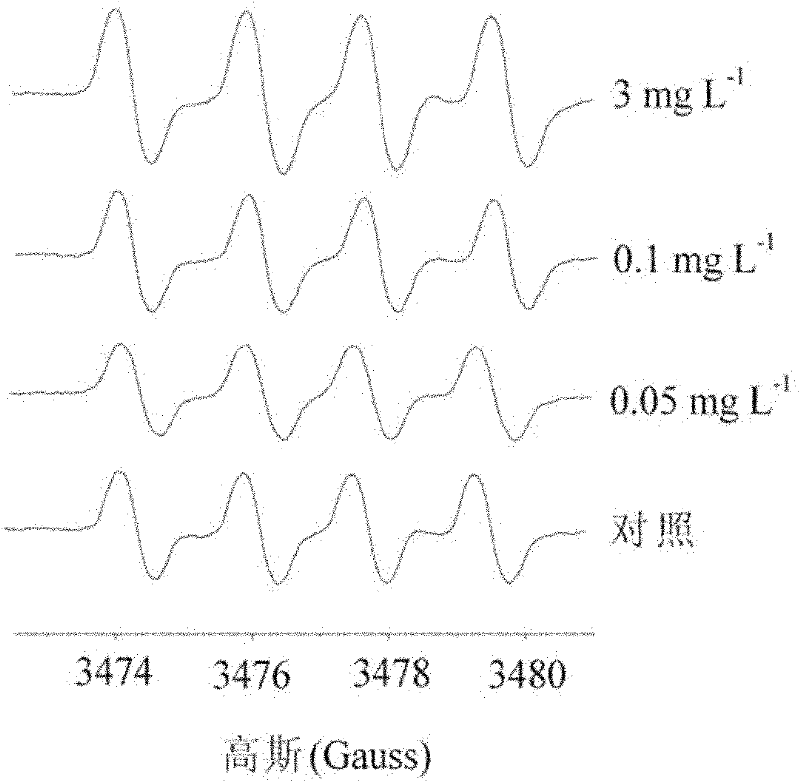Method for determining superoxide anion radicals in tape grass leaves
A superoxide anion and free radical technology, applied in the direction of electron paramagnetic resonance analysis, etc., can solve the problems of influence on promotion, lack of specificity of spectral peaks, and difficulty in accurate quantification of free radicals, etc. It is easy to master, simple to operate and practical broad effect
- Summary
- Abstract
- Description
- Claims
- Application Information
AI Technical Summary
Problems solved by technology
Method used
Image
Examples
Embodiment 1
[0029] Example 1 Determination of Superoxide Anion Free Radicals in Erythrina fragrans Leaves under Microcystin MC-LR Stress
[0030] The submerged plant Vallisneria natans (Lour.) Hara, which is common in freshwater environment in my country, was selected as the test organism. The plants are cultivated from commercial Erythrina chinensis seeds, and the culture solution adopts improved Hoagland nutrient solution (0.1×) and is prepared with tap water after aeration. The culture temperature is 25°C, the light intensity is 4000lux, and the photoperiod is 12 / 12h. Select well-growing seedlings with a height of about 10 cm and move them into a glass tank containing 5 cm of quartz sand, which contains Hoagland dilution. After domestication for several days, add different concentrations of MC-LR, and the exposure concentration is 0, 0.1, 0.5, 1.0, 5.0, 10.0 μg L -1 , each concentration group had 3 parallels, exposed for 14 days, changed the water every other day and added nutrient s...
Embodiment 2
[0034] Example 2 Determination of superoxide anion free radicals in leaves of Erythria galerica under ammonium nitrogen stress
[0035] The submerged plant Vallisneria natans (Lour.) Hara was selected as the test organism. The germination and cultivation of bitter grass plants are the same as in Example 1, and the plant seedlings with a height of about 10 cm are selected and moved into a glass jar containing 5 cm of quartz sand, containing nitrogen-free Hoagland dilution, and adding different concentrations of ammonium chloride to make NH 4 + -N exposure concentration reaches 0, 0.05, 0.1, 3.0 mg L -1 , each concentration group had 3 parallels, exposed for 14 days, changed the water every day and added ammonium chloride mother solution. After the exposure was completed, cut the tip part of the young leaves of the bitter grass, wash them with pure water, and quickly absorb the residual water on the surface of the leaves with filter paper. Quickly weigh about 0.3 g of plant l...
Embodiment 3
[0038] Example 3 Determination of superoxide anion free radicals in leaves of Erythria galerica under cadmium stress
[0039] The submerged plant Vallisneria natans (Lour.) Hara was selected as the test organism. The germination and cultivation of Erythrina fragrans plants are the same as in Example 1, and the culture solution adopts improved Hoagland nutrient solution (0.1×) and is prepared with tap water after aeration. The culture temperature is 25°C, the light intensity is 4000lux, and the photoperiod is 12 / 12h. Select plant seedlings with a height of about 10 cm that are growing well and transplant them into different Cd 2+ For the glass tank with high concentration sediment, the overlying water is aerated tap water balanced for 10 days (the bottom sediment used in the test was collected from a lake area of Taihu Lake, artificially added with different concentrations of chloride and aged for 60 days); each concentration group had 3 parallels, exposed for 14 days. Afte...
PUM
 Login to View More
Login to View More Abstract
Description
Claims
Application Information
 Login to View More
Login to View More - Generate Ideas
- Intellectual Property
- Life Sciences
- Materials
- Tech Scout
- Unparalleled Data Quality
- Higher Quality Content
- 60% Fewer Hallucinations
Browse by: Latest US Patents, China's latest patents, Technical Efficacy Thesaurus, Application Domain, Technology Topic, Popular Technical Reports.
© 2025 PatSnap. All rights reserved.Legal|Privacy policy|Modern Slavery Act Transparency Statement|Sitemap|About US| Contact US: help@patsnap.com



